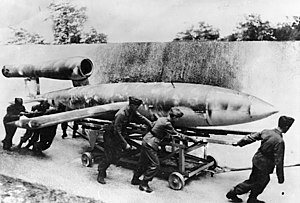
Back في-1 Arabic V-1 (raket) Azerbaijani Фау-1 Bulgarian V1 (fuc'hell) Breton Bomba volant V-1 Catalan V-1 Czech V1-missil Danish Fieseler Fi 103 German Ιπτάμενη βόμβα Greek V-1 Esperanto
| V-1 flying bomb Fieseler Fi 103 Flakzielgerät 76 (FZG-76) | |
|---|---|
 | |
| Type | Cruise missile |
| Place of origin | Nazi Germany |
| Service history | |
| In service | 1944–1945 |
| Used by | Luftwaffe |
| Wars | World War II |
| Production history | |
| Designer | Robert Lusser |
| Manufacturer | Fieseler |
| Unit cost | 5,090 RM[1] |
| Specifications | |
| Mass | 2,150 kg (4,740 lb) |
| Length | 8.32 m (27.3 ft) |
| Width | 5.37 m (17.6 ft) |
| Height | 1.42 m (4 ft 8 in) |
| Warhead | Amatol-39, later Trialen |
| Warhead weight | 850 kg (1,870 lb) |
Detonation mechanism |
|
| Engine | Argus As 109-014 Pulsejet |
Operational range | 250 km (160 mi)[2] |
| Maximum speed | 640 km/h (400 mph) flying between 600 and 900 m (2,000 and 3,000 ft) |
Guidance system | Gyrocompass based autopilot |
The V-1 flying bomb (German: Vergeltungswaffe 1 "Vengeance Weapon 1"[a]) was an early cruise missile. Its official Reich Aviation Ministry (RLM) designation was Fieseler Fi 103[3] and its suggestive name was Höllenhund (hellhound). It was also known to the Allies as the buzz bomb or doodlebug[4][b] and in Germany as Kirschkern (cherry stone)[c] or Maikäfer (maybug).[d]
The V-1 was the first of the Vergeltungswaffen (V-weapons) deployed for the terror bombing of London. It was developed at Peenemünde Army Research Center in 1939 by the Luftwaffe at the beginning of the Second World War, and during initial development was known by the codename "Cherry Stone". Due to its limited range, the thousands of V-1 missiles launched into England were fired from launch facilities along the French (Pas-de-Calais) and Dutch coasts or by modified He 111 aircraft.
The Wehrmacht first launched the V-1s against London on 13 June 1944,[6] one week after (and prompted by) the successful Allied landings in France. At peak, more than one hundred V-1s a day were fired at southeast England, 9,521 in total, decreasing in number as sites were overrun until October 1944, when the last V-1 site in range of Britain was overrun by Allied forces. After this, the Germans directed V-1s at the port of Antwerp and at other targets in Belgium, launching a further 2,448 V-1s. The attacks stopped only a month before the war in Europe ended, when the last launch site in the Low Countries was overrun on 29 March 1945.
As part of operations against the V-1, the British operated an arrangement of air defences, including anti-aircraft guns, barrage balloons, and fighter aircraft, to intercept the bombs before they reached their targets, while the launch sites and underground storage depots became targets for Allied attacks including strategic bombing.[7]
In 1944, a number of tests of this weapon were apparently conducted in Tornio, Finland. On one occasion, several Finnish soldiers saw a German plane launch what they described as a bomb shaped like a small, winged aircraft. The flight and impact of another prototype was seen by Finnish frontline soldiers; they noted that its engine stopped suddenly, causing the V-1 to descend sharply, and explode on impact, leaving a crater 20–30 metres (66–98 ft) wide. These V-1s became known to Finnish soldiers as "flying torpedoes".[8]
- ^ Zaloga 2005, p. 11.
- ^ Werrell 1985, p. 53.
- ^ Christopher 2013, p. 108.
- ^ a b Vanek 1999, p. 81.
- ^ Lloyd & Hall 1997, p. 222.
- ^ Frederick French. "War and peace and the price of cat-fish". Uncle Fred's diaries. Archived from the original on 7 July 2017. Retrieved 16 June 2014.
- ^ American Sub Rescues Airmen. Universal Newsreel. 1944. Retrieved 21 February 2012.
- ^ Tornio 1944 by Osmo Hyvönen page 262, Ilmasotaa Torniossa
Cite error: There are <ref group=lower-alpha> tags or {{efn}} templates on this page, but the references will not show without a {{reflist|group=lower-alpha}} template or {{notelist}} template (see the help page).
© MMXXIII Rich X Search. We shall prevail. All rights reserved. Rich X Search